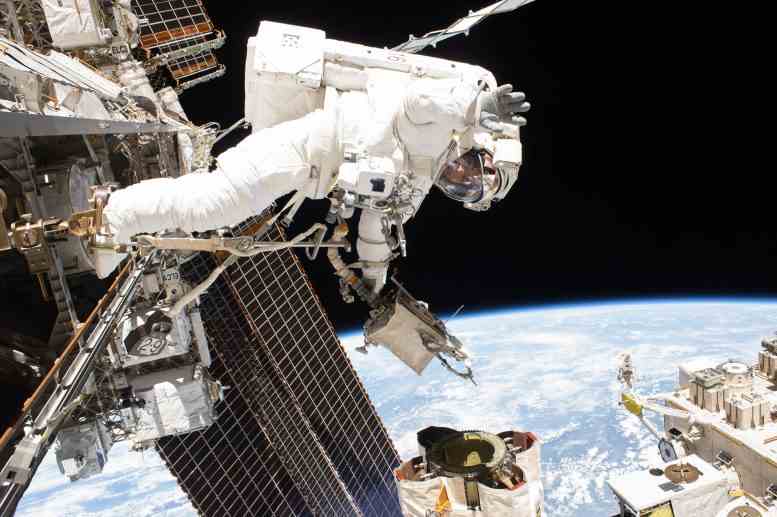An Bord der Internationalen Raumstation quetscht sich der NASA-Astronaut Mark Vande Hei in die Zeit, um sich mit einem Buch zu entspannen. Vande Hei hat es am Dienstag, den 15. März 2022, in die Rekordbücher geschafft und den Rekord für die meisten aufeinanderfolgenden Tage im Weltraum eines amerikanischen Entdeckers gebrochen. Bildnachweis: NASA/ESA/T. Pesquet
Vande Hei hat es am Dienstag, den 15. März 2022, in die Rekordbücher geschafft: Er hat den Rekord für die meisten aufeinanderfolgenden Tage im All eines amerikanischen Entdeckers gebrochen.
Vande Hei kam am 9. April 2021 auf der Raumstation an und wird voraussichtlich am 30. März 2022 nach Hause zurückkehren, nachdem er 355 Tage im erdnahen Orbit verbracht hat. Diese Dauer bricht den bisherigen Rekord von[{” attribute=””>NASA astronaut Scott Kelly, by 15 days.
His then-crewmate Thomas Pesquet, who snapped the picture, said: “If you are reading this sitting down, maybe on a sofa or couch, consider that we will not sit down… until we are back on Earth! Of course, we don’t need to sit down up here, and I am not complaining at all, but sometimes that wonderful feeling of relaxation – that moment when you change from running around to letting yourself drop into a chair – that moment can be wonderful I am sure you all agree, and we do miss it sometimes! I think Mark did here too and made a makeshift reading table to enjoy a book – absolutely unnecessary in weightlessness but so nice to construct some semblances of normal life every now and again!”
Die Beiträge des rekordverdächtigen NASA-Astronauten Mark Vande Hei zu Human Research Studies
Der NASA-Astronaut Mark Vande Hei kam am 9. April 2021 auf der Internationalen Raumstation an und wird voraussichtlich am 30. März 2022 nach Hause zurückkehren, nachdem er 355 Tage in einer erdnahen Umlaufbahn verbracht hat. Diese Dauer bricht den bisherigen Rekord des pensionierten NASA-Astronauten Scott Kelly um 15 Tage.
Vande Hei wird planmäßig zusammen mit den Kosmonauten Pyotr Dubrov und Anton Shkaplerov in einem Sojus-Raumschiff zurückkehren.
Während er den längsten Einzelraumflug eines NASA-Astronauten absolvierte, trug Vande Hei zu Dutzenden von Studien aus den Hunderten bei, die während seiner Mission durchgeführt wurden, darunter sechs wissenschaftliche Untersuchungen, die vom Human Research Program (HRP) der NASA unterstützt wurden.
„Unsere Astronauten sind unglaubliche Entdecker, die dazu beitragen, unser Wissen darüber zu erweitern, wie Menschen über längere Zeiträume im Weltraum leben und arbeiten können“, sagte NASA-Administrator Bill Nelson. „Marks rekordverdächtige Mission und seine Beiträge zur Wissenschaft ebnen den Weg dafür, dass mehr Menschen mit länger andauernden Missionen in den Weltraum reisen, da die Agentur die Grenzen der Erforschung des Mondes und der Erde erweitert[{” attribute=””>Mars. Thank you for your service, Mark, and congratulations!”

NASA astronaut and Expedition 53 Flight Engineer Mark Vande Hei is pictured during a spacewalk to service components on the Canadarm2 robotic arm during a spacewalk with NASA astronaut Randy Bresnik (out of frame). (October 10, 2017) Credit: NASA
For one investigation, Vande Hei helped grow and evaluate vegetables harvested with the space station’s Vegetable Production System, or Veggie. The investigation seeks to develop a food production system that can help astronauts meet their dietary needs with fresh vegetables cultivated in space.
Vande Hei also provided biological samples for an investigation that collects a core set of measurements, called Spaceflight Standard Measures. The investigation seeks to characterize “normal” changes in the human body during spaceflight. For instance, wrist-worn sensors that measure activity levels and light exposure can help researchers better understand the sleep-wake cycle of astronauts. Blood and saliva samples collected by crew members throughout their mission can also help scientists assess changes in various hormones, proteins, and cells that reveal how the immune system changes in space.
In addition, he contributed to a separate investigation collecting biological samples from the crew aboard the space station and placing them in a storage bank. Researchers can draw upon the samples to study spaceflight-induced changes in human physiology.
Vande Hei also participated in the first formal investigation into how eating repetitive meals in spaceflight changes the appeal of certain foods over time. In space, menu fatigue can have serious consequences, including lost appetites, nutritional deficiencies, and loss of body mass. Results will help researchers improve the design of current and future space food systems.
He is also the first astronaut on an extended mission to help researchers investigate whether an enhanced spaceflight diet can allow humans to better adapt to space. Scientists seek answers to questions such as: Could a diet packed with foods rich in nutrients such as flavonoids, lycopene, and omega-3 fatty acids boost immunity and gut microbe function on long journeys into space?
After he lands, Vande Hei will provide additional feedback to researchers investigating potential injuries such as bruises incurred by astronauts from the force of landing. This feedback will help scientists better understand whether long-term human spaceflight makes crew members more susceptible to such injuries. Results will also help NASA design protective measures in future spacecraft.
Vande Hei’s contributions will expand NASA’s knowledge about how the human body adapts to long-term spaceflight as the agency plans for future missions to the Moon and Mars. Until then, taking time to relax and read will help him balance out the rigors of space travel.
NASA’s Human Research Program, or HRP, pursues the best methods and technologies to support safe, productive human space travel. Through science conducted in laboratories, ground-based analogs, and the International Space Station, HRP scrutinizes how spaceflight affects human bodies and behaviors. Such research drives HRP’s quest to innovate ways that keep astronauts healthy and mission-ready as space travel expands to the Moon, Mars, and beyond.

